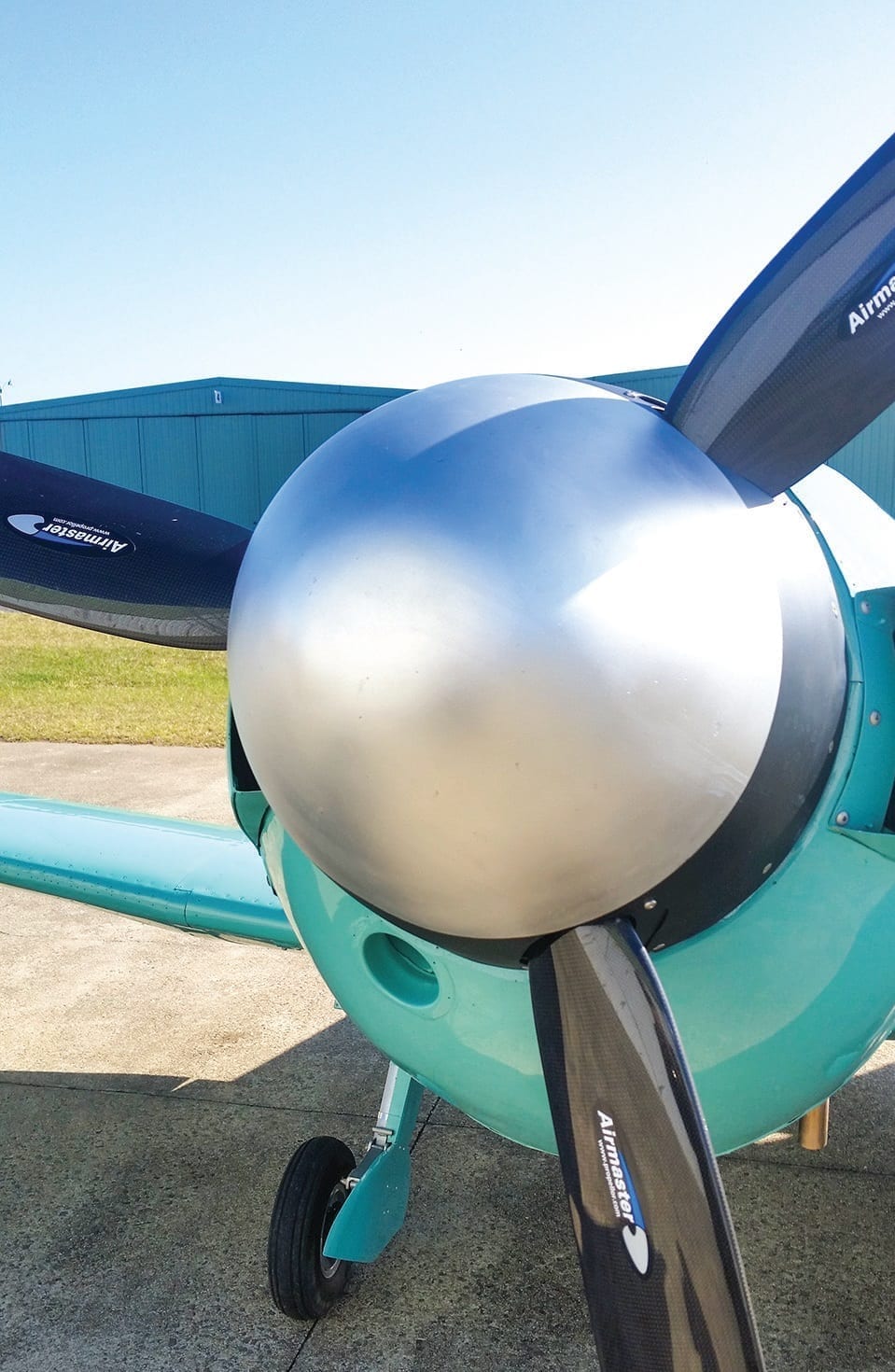Tags: Airplanes. History. Spitfire. War. Military. WW2.
In the Air
NEIL COOPER and the SPITFIRE 5054 Replica
The Supermarine Spitfire was first developed in the mid-1930’s as a short-range, high-performance interceptor and was one of the most well-known aircraft to be involved in the defence of Britain during World War II. Detailed design work on what was initially known as the Type 300 began in November 1934 and on December 1st of that year, the Air Ministry issued contract AM 361140/34, allowing 12,000 pounds as funding for the construction of a single prototype.
Featured Image(above): The spinner is from a Viscount – a tribute to Neil’s dad
Ready for it’s maiden flight by early 1936, the prototype of the Spitfire was allocated the military serial number K5054 and, with Captain Joseph “Mutt” Summers (chief test pilot for Vickers) at the controls, the aircraft made its maiden flight from Eastleigh Aerodrome on March 5th of that year. Captain Summers reported that the aircraft handled beautifully. The RAF went on to place an initial order for 310 Spitfires before testing was even completed and after further modifications, fine-tuning and receiving a coat of cerulean blue paint which was actually an automotive lacquer, the prototype was delivered to RAF Martlesham Heath for service evaluation on May 26th, 1936.
Prototype K5054 continued to be used as a platform for further testing and modifications and just two days after the beginning of World War II, the aircraft was destroyed during an awkward landing on 4th September in 1939. There are a number of K5054 replicas that have been built by enthusiasts throughout the world, some flying and others non-flying and one of these is the Tangmere replica on display at Duxford which is a memorial to designer RJ Mitchell.

The Original
As it so happens, there is one K5054 three quarter scale flying replica which, although hangered at Archerfield in Brisbane, is a regular visitor to the Caboolture Airfield and along with that can be often seen in the skies over Bribie Island. The aircraft is owned by Virgin Airlines Senior Training Captain Neil Cooper who purchased it eighteen months ago whilst it was still being built by enthusiast Chris Weaver.

Some of the switches and instruments are from a Spitfire
Neil told me that after he took over ownership, Chris remained involved with the completion of the project and he also explained about how they were able to use the exact same colour as that of the original aircraft. ‘We discovered that Sir Reginald Mitchell had given his son a model car and that had been painted with leftover paint from the Spitfire prototype,’ said Neil. ‘We were able to get a colour match from a British Museum and Paint our replica in cerulean blue. From when it began, the build took a total of eight years to complete,’ he added.
Neil’s Spitfire replica is a wonderful example of craftsmanship and even includes some parts from a factory built Spitfire. As well as some of the switches and instruments, the pitot head is also from a Spitfire. In order to keep it within the RA-Aus (Recreational Aviation Australia) regulations and registration, the replica has been fitted with a 912 Rotax powerplant and bears the registration numbers 19-6054 although the tail displays the original serial number 5054.

The Spitfire replica is painted in cerulean blue – the exact same colour as the prototype
I asked Neil, who is Brisbane born and bred, about his career in aviation and his response, whilst not exactly what I was expecting, demonstrated that if you have the commitment, almost anything is possible. Before I worked for the airlines, I was a television cameraman in New Zealand for twenty-three years and, after I learned to fly, I acted as the pilot for the TV channel and I flew all across the country filming a gardening show,’ Neil told me. ‘That was basically how I got my hours up and then I had a flying school,’ he said. Neil also remarked that his brother is also an airline pilot and his dad flew for Ansett.

Neil Cooper is justifiably proud of his replica Spitfire
‘My father was killed in a Viscount crash near Winton in 1966 and the spinner (the silver part at the centre of the propeller) on the Spitfire replica is from a Viscount,’ Neil pointed out. ‘that is like a special tribute to him,’ said Neil. When seen up close on the ground, the replica is easily recognised as only threequarters of the size of the Spitfire but if one views the aircraft flying overhead, it becomes almost impossible to distinguish it from what many people saw in the skies during the conflict that it played such a major part in. Neil commented that whenever he flies over the island people usually look up and wave. ‘That doesn’t happen if you’re flying a Cessna,’ he said.
An easily recognisable feature of the Spitfire is its elliptical wing shape so if anyone who has read this article spots an aircraft with wings of that shape, it will most likely be Neil Cooper. Give him a big wave to let him know that he is always welcome in our skies.
Other Articles
https://thebribieislander.com.au/history-royal-flying-doctor-service/
